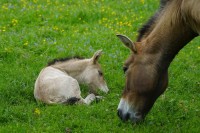
Genetic relationships between domestic and wild horses
Pleistocene (2,58 million- 11,7 thousand) - Large herds of wild horses where common on the open plains of Europa, Asia and North America. By the end of the ice age the numbers of all wild horses were reduced due to climate and vegation shift. Horses also rapidly declined in body size and the horses in North America became extinct around 10.500 BC. In Eurasia only two species survived, the Tarpan and the Prezwalski. (Both notorious of stealing domesticated mares and breed with them). Exmoor ponies from Britain were also claimed to be a direct descendant from Britisch Pleistocene stocks.
Why horses are domesticated is questionable. There is no hard evidence, just a bunch of theories. Horse keeping could have started out just for the food. It could be that the first horses where used to hunt down other cattle including horses. This would have been around 5000 BC, but there is no real record of it. The first signs of horseback riding with a bit dates back to 3500-3000 BC. And the first hard evidence is around the end of the third millennium BC. At the beginning of the seconde millenium BC horses where widely used.
Domestication has had little impact on the anatomy of the early domesticated horses. Horse population show high variability throughout the Pleistocene into the mid-Holocene (7000 - 5000 BC). By 1500 BC, what is called the early phase of domestication, already 2 definitions where known. One groups were the "Celtic" ponies. These where small and sturdie. And the others where more, what we would call it today, Arabian like horses. The domestication development has taken a long time and wild horses where up until relatively recent (medieval) included in the breeding proces.
Three groups of horses where researched for there mtDNA or haplotype mutations (both widely used for studying the history of maternal lines). Current breeds were in group one. Second they looked into ancient domestic horses and third from extant wild horses but also from pleistocene periode. All groups contained horses from all over the world.
It seemed that the majority of het North American haplotypes dit not occure in recent horses. This underlines there was no inlvolvement of these horses in the proces of domestication because they where all extinced by the time domestication took place.
There where 2 large bottlenecks in surviving of the male lines. 8000 years ago due to climate en vegitation and later due to domestication around 6000 years ago. All current horses can be traced back to one founder stallion (or closely related). That suggest that less stallions and lots of mares where involved in the breeding. That could be an indicator for domestication. Humans were more in control of breeding horses and this could have accelerated the proces of domestication.
> From: Kavar et al., Livestock Science 116 (2008) 1-14. All rights reserved to Elsevier B.V.. Click here for the online summary.


